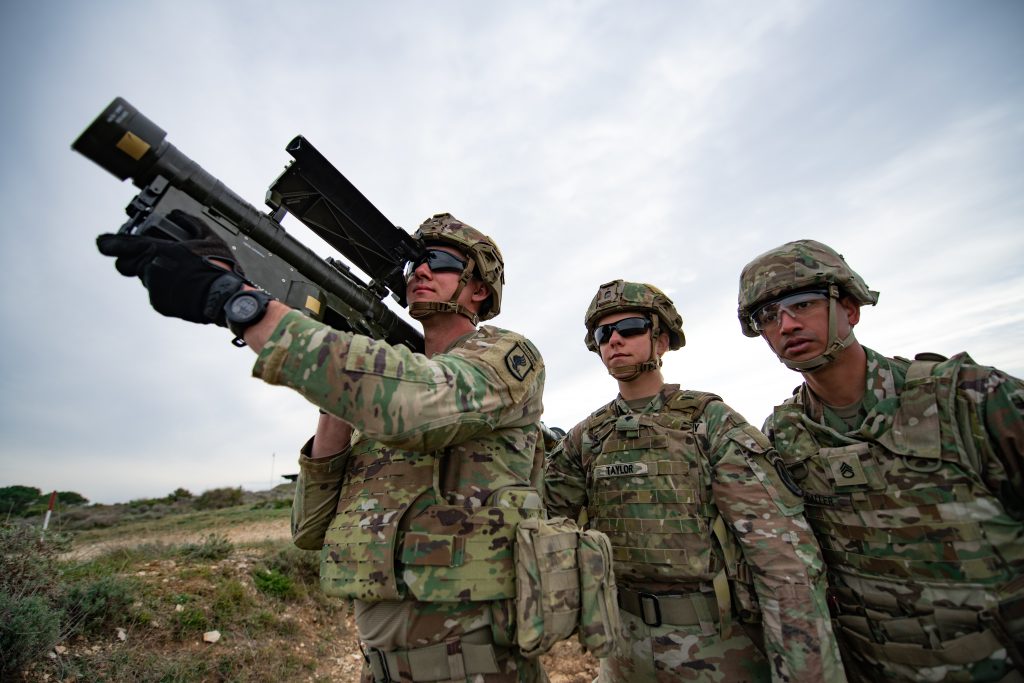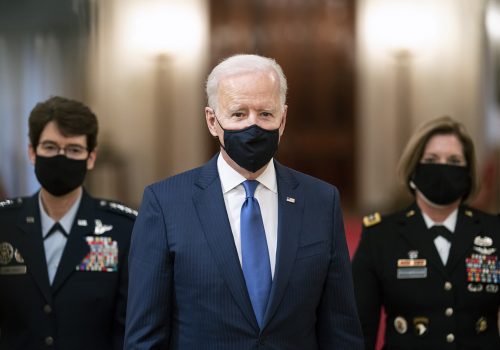
After a lengthy build-up—then delays prompted by Russia’s war in Ukraine—the public release of the next National Defense Strategy (NDS) is finally upon us. And although the full reveal is expected in the next few weeks, we have already received a glimpse at the contours of the document that will guide the Pentagon’s policy making over the coming years.
Last month, the US Department of Defense (DoD) announced that it had sent the classified version of the NDS to Congress—along with the classified Nuclear Posture Review (NPR) and Missile Defense Review (MDR)—and released a two-page fact sheet providing the major elements of the strategy.
As we await the unclassified summaries of each document, the DoD’s press releases answered some critical questions about these strategies while igniting others. Experts from the Scowcroft Center for Strategy and Security tackled the seven most pressing questions about the forthcoming documents.
1. The new NDS appears to have reprioritized the threats facing the United States to a “1+1+3” construct —with China described as the “most consequential strategic competitor,” followed by “acute threats” from Russia, and then “persistent threats, including those from North Korea, Iran, and violent extremist organizations.” What does this prioritization of threats mean, and what do you think the implications are for the rest of the document?
This “1+1+3” construct seems roughly right to me, but the devil is in the details.
First, we should be modest about our intelligence in the US national security establishment and not have false confidence about which threats might manifest in which ways by specific actors. We are very good at being surprised on a frequent basis.
That said, top threats to US national security must be clarified so that planning and budget development can proceed. The 2022 NDS’s prioritization between great-power threats and other challenges, such as Iran, should be stark enough that DoD decision makers leave the table feeling uncomfortable about taking risks in other areas in order to ensure that policies and posture focused on the two great powers are sufficient. This very clear Tier One pair of threats should have enterprise-wide implications for DoD, ranging from global military posture (for example, the US Army should prioritize Europe) to defense programs, research and development (R&D) priorities, and infrastructure.
Third, how Russia is perceived in DoD must absolutely change going forward. The culture over the past twenty years has been to treat Russia as “pesky” but not nearly the same nature and level of structural challenge as the Chinese People’s Liberation Army. Strangely, despite the ongoing war in Ukraine, this perception does not yet appear to have changed. Despite Russia’s relative weakness compared to China’s unfolding upward geopolitical trajectory, it almost certainly will remain a significant military threat to the United States and Europe for decades, even after Russian President Vladimir Putin leaves the stage. It is a threat that must be managed, as it cannot be “solved.”
Finally, how can DoD handle the worst-case scenario—a nearly simultaneous threat of war posed by China and Russia (whose cooperation “has no limits” according to their leaders’ February joint statement)? The answer has three parts:
- Strategy-driven US capability and R&D investments to prepare the force of the late 2020s to strengthen deterrence against China and Russia, including heavy investments in artificial intelligence, hypersonic weapons, non-kinetic missile defenses, unmanned or uncrewed systems, and other advanced capabilities.
- Intensive diplomacy with the United States’ closest allies toward a new and much clearer set of defined roles in both Europe and the Indo-Pacific, with radically closer cooperation and significantly increased allied defense spending at the heart of a revamped, US-led “latticed” alliance network of democratic countries.
- Increased reliance on US strategic forces for extended deterrence. China is undertaking a full-throttle nuclear force buildup, and Russia already modernized its strategic capabilities and rattled the nuclear saber in the Ukraine war (it certainly will do so again in the future). In the Cold War, the United States leveraged strategic forces for deterrence against attack by a much larger Russian conventional force. Now, as the United States and its allies face a much larger aggregated military threat posed by Russia and China, strategic forces should be postured to do so again.
—Barry Pavel, senior vice president and director of the Scowcroft Center for Strategy and Security at the Atlantic Council, and former special assistant to the president and senior director for defense policy and strategy on the National Security Council staff.
2. The forthcoming NDS calls out the “growing kinetic and non-kinetic threats to the United States’ homeland from our strategic competitors” and vows to “take necessary actions to increase resilience.” What are these threats, and how can the United States increase its resilience to them?
The United States needs to recognize several categories of increasing non-military threats: cybersecurity and cyber crime; threats to critical infrastructure from climate change and hostile foreign actors; foreign nation states carrying out mis-, dis-, and mal-information operations; pandemic disease; and efforts to sow divisions among the American people. The primary targets of these threats are not the US military—but rather American people and civilian infrastructure. DoD will need to protect the military from these threats and stay ahead of major strategic shifts caused by Russia, China, Iran, and climate change. However, for many of these non-military threats, DoD needs to play a vital supporting role to civilian security efforts. One of DoD’s most important contributions should be a call for more resources and support to civilian security efforts. Then General James Mattis famously said in 2013 that under-funding the State Department forces DoD to buy more bullets. Under-investment in diplomacy and development means that the military must do more to make up the shortfall. The same can also be said today about the strategic dangers of under-investing in civilian security. The US military is a powerful instrument of national power—but against many of today’s hybrid threats, investing in civilian security is far more cost-effective and better defends the American people and infrastructure from its adversaries.
—Thomas S. Warrick, senior fellow at the Scowcroft Center for Strategy and Security and a former senior official at the Department of State and deputy assistant secretary for counterterrorism policy at the Department of Homeland Security.
3. Like the 2018 NDS, the forthcoming strategy recognizes the “critical” importance of “mutually-beneficial Alliances and partnerships.” According to DoD, the NDS will “incorporate ally and partner perspectives, competencies, and advantages at every stage of defense planning.” How can DoD more meaningfully integrate allies and partners into defense planning and ensure this NDS is more successful than the last one in providing actionable tasks to improve integration?
The importance of working with allies and partners has long been a feature of US National Defense Strategies, and rightly so. Previous strategies, however, have fallen short on providing specific and actionable guidance on how to integrate allies’ and partners’ threat assessments and capabilities into US defense plans. What stands out to me is the fact sheet’s reference to “incorporat[ing]” allies and partners at “every stage of defense planning” (emphasis mine), indicating a potential shift in approach from integrating allies into existing US plans to more collaborative defense planning with allies. Without the details, it is unclear precisely the mechanisms and in what capacity allies’ and partners’ “perspectives, competencies, and advantages” will be integrated, but the Biden aadministration appears to have heeded early lessons from Russia’s war in Ukraine about the importance of advanced allied defense planning and interoperability.
The details matter, but involving allies at every stage and much earlier in the defense planning process would be an important step in the right direction. Currently, the United States does not incorporate allies into its defense planning process early, often, or comprehensively. The fact sheet indicates that DoD may be moving toward this. It should concentrate on aligning existing national defense plans earlier and more often, as well as jointly creating plans from the get-go instead of trying to absorb allies into pre-determined US plans later on. While challenges regarding information sharing abound, some US processes are needlessly restrictive and hamper integration with allies. Meaningful efforts to overcome these barriers and move toward combined defense planning, including aligning threat assessments, capability development plans, and force arrangements and posture—especially in regions like Europe and the Indo-Pacific where allies will play an active role in deterrence and warfighting—would put the United States in a better position to balance its many global security objectives.
Allies are often looking for clearer guidance from the United States for their defense planning purposes. If DoD is serious about building a robust deterrence and defense architecture with allies and partners, the full document must provide clear implementation guidance for allied integration in warfighting concept development, operational planning, and tactics and doctrine development, revision, and training.
—Clementine Starling, resident fellow and deputy director of Forward Defense at the Scowcroft Center for Strategy and Security.
4. According to the NDS press release, one of the primary “ways” DoD will accomplish its goals is through “integrated deterrence.” How can DoD implement this broader joint, “whole-of-government,” and “whole-of-alliances and partnerships” deterrence against Washington’s strategic competitors?
Upon its introduction by Secretary of Defense Lloyd Austin and key members of DoD senior leadership, “integrated deterrence” clearly had become central to the next NDS. While the concept is not yet fully developed (at least not publicly), the NDS fact sheet confirmed that it is designed to expand the responsibility for deterring adversaries beyond the Department of Defense. The fact sheet also represents a departure from the 2018 NDS in that deterrence is no longer only an “objective,” but also a “way” of implementing the strategy—implying that the department will actively rethink and calibrate its deterrent posture.
Integrated deterrence is likely a response to the multifaceted security landscape. In an environment defined by “strategic simultaneity” among numerous threats, the United States’ longstanding reliance on nuclear weapons, while essential, will not be sufficient to credibly deter every form of adversary aggression, which may range from information operations to economic competition, and from conventional military invasion to nuclear coercion. Other military, non-military, and allied and partner tools will be necessary. However, the National Security Council is already designed to integrate instruments of national power and ensure coordination among other agencies, so it is not entirely clear how integrated deterrence will be markedly different from existing approaches to US statecraft or whether the Pentagon’s role in that process will change.
If integrated deterrence is to have a meaningful impact, policymakers should take the following steps:
- Robustly integrate nonnuclear strategic forces. Emerging technologies like hypersonic weapons, advanced missile defenses, and cyber tools may undermine the existing legs of the nuclear triad. Policymakers should rethink the balance of strategic forces necessary to deter major attacks in the future, including by eventually replacing the Nuclear Posture Review and Missile Defense Review with a more comprehensive Strategic Posture Review that explores how nuclear and conventional forces can complement each other.
- Clearly coordinate deterrence objectives and responsibilities across agencies. As demonstrated by the Russian invasion of Ukraine, sanctions and other non-military tools can often be insufficient to deter military action, though they can be helpful in compelling changes in adversary behavior or deterring hybrid actions. The Biden administration should establish a mechanism for determining which adversary behaviors are consequential enough to be deterred by force (i.e., under the remit of the Department of Defense) and which outcomes can be credibly deterred through non-military means (i.e., under the remit of other agencies).
- Integrate allies comprehensively into defense planning. Many of the fait accompli attacks that concern defense planners would first be felt by US allies and partners. It is critical to work closely with them to determine how they can best blunt adversary attacks and buy time for US and other allied support, among other operational imperatives.
—Christian Trotti, assistant director of Forward Defense at the Atlantic Council’s Scowcroft Center for Strategy and Security.
5. Another of the NDS’s “ways” is “campaigning.” According to DoD, this concept will address the “full range of competitors’ coercive actions,” seeming to indicate campaigning will occur across the continuum of competition and conflict. In what ways can and should DoD improve its day-to-day campaigning? In what areas must DoD invest, develop doctrine and tactics, and train to improve competitive efforts?
The 2018 NDS reoriented DoD toward great-power competition, now known as “strategic competition.” But that document failed to provide guidance on how to compete. The press release for the 2022 NDS indicates that this strategy will use “campaigning” as the way DoD competes with China and Russia. This campaigning must occur across the competition continuum, which DoD defines as “enduring competition conducted through a mixture of cooperation, competition below armed conflict, and armed conflict,” including in the so-called “gray zone” (where malign activities have proven unlikely to elicit a response from the United States). Cyberattacks, mis- and disinformation campaigns, and fait accompli actions such as the Chinese construction and militarization of rocks and shoals in the South China Sea are examples of competitors’ gray-zone activities. DoD must become comfortable operating in the gray zone and countering adversary mis- and disinformation campaigns with facts (as had been demonstrated by the declassification and release of intelligence during the build-up to the war in Ukraine).
Additionally, the United States must be willing to counter cyberattacks and fait accompli tactics with a range of options designed to not only halt competitors’ momentum, but also create offensive momentum for the United States and its closest allies and partners. DoD must create units tasked with conducting offensive and defensive operations in the gray zone, using information as a weapon while conforming to US laws and norms. It must also develop doctrine and tactics for these types of operations and integrate these efforts into greater competition campaigns.
Finally, DoD should recognize that the military is just one instrument the United States can wield in the gray zone; all instruments of national power must be used to counter great-power competitors. The next NDS appears to embrace this whole-of-government approach, and according to the press release, DoD will indeed “operate forces, synchronize broader Department efforts, and align Department activities with other instruments of national power.”
— Lt. Col. Tyson Wetzel, senior US Air Force fellow at the Atlantic Council’s Scowcroft Center for Strategy and Security. The positions expressed by Lieutenant Colonel Wetzel do not reflect the official position of the United States Air Force or Department of Defense.
6. In addition to its fact sheet for the NDS, the DOD also released a fact sheet on the Nuclear Posture Review (NPR) and Missile Defense Review (MDR), with the goal of “conduct[ing] its strategic reviews in a fully integrated way.” What are the main takeaways of these, and how do they align with the NDS? Will they have any noticeable positive effect in creating a coherent deterrence strategy?
Let’s start with what’s missing. Despite the much vaunted “integration” of the NDS, NPR, and MPR, the fact sheets do not offer much indication as to how the administration actually intends to (more closely) integrate nuclear weapons into overall strategic deterrence. If anything, the decision to adopt a “fundamental role” declaratory policy dis-integrates nuclear weapons from overall deterrence by reducing their prominence in deterring other kinds of major attacks. Whereas the United States previously expressed a willingness to use nuclear weapons in response to non-nuclear strategic attacks (such as ones on US early warning satellites, or an overwhelming conventional attack against a US ally), now those options are left more ambiguous. At the risk of criticizing style over substance, even the decision not to integrate the three fact sheets into one document highlights this disconnect.
The Biden administration faced many major unresolved nuclear policy debates, but the NPR fact sheet primarily addresses one: its decision on declaratory policy, which expressed how the United States sees the purpose of nuclear weapons. The Biden administration will adopt the “fundamental role” language used in the Obama administration’s 2010 NPR. This language will displease proponents of the Trump administration’s 2018 NPR, which laid out a broader view of the purpose of US nuclear weapons. It also could disappoint those on the left: Many progressive nuclear experts hoped that the Biden administration would go further to curtail the purpose of nuclear weapons and the circumstances under which they could be used (they see this ambiguity as dangerous).
Lastly, the NPR fact sheet makes no mention of capabilities, but the Biden administration’s budget proposal tells a different story. The administration requested no additional funding for the SLCM-N, the low-yield nuclear sea-launched cruise missile. The SLCM-N was proposed in the 2018 NPR by the Trump administration as a way to counter Russia’s possible threats to use low-yield nuclear weapons to end a conflict early (and on terms favorable to Russia). Its absence from the Biden administration’s budget suggests that the administration is trying to find a way to keep Biden’s campaign promise of reducing the role of nuclear weapons. Congress, however, still has the capability to restore funding to the project, so the debate on the SLCM-N likely isn’t over.
—Mark J. Massa, assistant director in the Forward Defense practice of the Scowcroft Center for Strategy and Security at the Atlantic Council and Alyxandra Marine, program assistant in the Forward Defense practice.
7. On the same day DoD transmitted the NDS, NPR, and MDR to Congress, it also released the president’s Fiscal Year (FY) 2023 budget request. Will the requested $773 billion budget (which would be a 4.1 percent increase) allow DoD to meet the goals and objectives established in its strategy documents?
The proposed DoD topline of $773 billion, plus atomic energy defense and other defense-related activities, comes to a total National Defense Budget proposal of $813.3 billion—only $17.2 billion more than the combined total defense spending in FY2022. Adjusted for current inflation levels, this 2 percent increase means actual defense spending is declining by 6.5 percent. Unfortunately, inflation will likely continue to increase in FY2023, further eroding defense buying power. If the United States is serious about meeting the challenge laid out in the NDS, it cannot afford significant reductions in defense spending.
There is strong bipartisan support on Capitol Hill for increased defense spending to account for inflation. In fact, Congress gave the Pentagon $40 billion more than it asked for in FY2022. The United States should seriously consider the recent proposal by Sen. James M. Inhofe, the top Republican on the Senate Armed Services Committee, to fund defense spending at inflation plus 5 percent for FY2023 to counter inflationary pressure and maintain the US advantage over its adversaries. If that proposal is adopted and inflation stays at 8.5 percent, total defense spending would climb to more than $900 billion.
— Col. John “Buss” Barranco, senior US Marine Corps fellow at the Atlantic Council’s Scowcroft Center for Strategy and Security. The positions expressed by Colonel Barranco do not reflect the official position of the United States Marine Corps or Department of Defense.
Further reading
Fri, Apr 15, 2022
Going Nordic: What NATO membership would mean for Finland and Sweden
New Atlanticist By
As both countries inch toward formally joining the Alliance, we answer six burning questions about what the future holds.
Tue, Mar 8, 2022
What are the risks and benefits of US/NATO military options in Ukraine? Our strategic risk calculator has answers.
The Big Story By Tyson Wetzel, Barry Pavel
A strategic risk calculator for policymakers on both sides of the Atlantic to assess the possible risks and benefits of boosting their military assistance to the Ukrainian government.
Fri, Apr 2, 2021
Recalculating the math of great-power competition
Seizing the advantage By Arun Iyer
To better serve US interests, the Biden administration should recalculate the DoD’s GPC framework to address the threats that the country is most likely to confront, while improving the United States’ preparedness for the most dangerous threats. It should replace the single “2+3” concept with three multilayered and interactive frameworks nested upon one another.
Image: US Army paratroopers assigned to the 173rd Airborne Brigade practice acquiring a target with a FIM-92 Stinger during an air defense live-fire exercise alongside soldiers with the Croatian Air Defense Regiment. This training is part of Exercise Shield 22 at Kamenjak near Medulin, Croatia on April 9, 2022. Photo by US Army/Cover Images via Reuters.



